Isis & the Wandering Goddesses at Philae
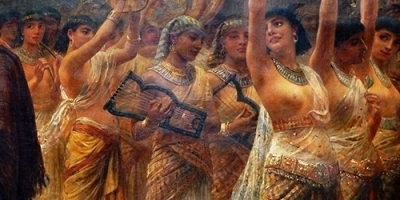 Procession for Her return
Procession for Her returnIf you’ve been reading along with this blog, you may know that I believe we should count Isis as one of Egypt’s Wandering Goddesses. You can read about that here, here, and here. As we recently had our local Summer Solstice festival—in which we honored the Wandering Goddesses Sakhmet and Hathor—well, Wandering Goddesses are on my mind.
So, I’d like to uncover for you some of the footprints of the Wandering Goddess that we can find at Isis’ famous temple at Philae. (Read more about that beautiful temple here.) You may recall that Philae is located at what was the southernmost border of Egypt.
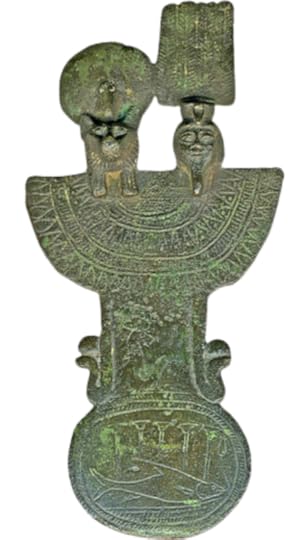 Tefnut & Shu on a menat weight
Tefnut & Shu on a menat weightIn the Wandering Goddess myths, when the angry Goddess leaves Egypt, She often goes south “to Nubia” (i.e. “gets the hell outta here“). Famously, Tefnut—Isis’ grandmother—is one of the Goddesses Who specifically goes to Nubia. Eventually, She is coaxed back by Thoth in the form of a fable-telling monkey. As Tefnut returns, She travels north from Nubia. Thus, Isis’ temple at the southernmost outpost of Philae is the Goddess’ first stop on Her return trip home.
But since we’re talking about Egyptian Goddesses here, everything is a little bit more complicated than that. Because when Tefnut makes Her stop at Philae, She is not just Tefnut, but also Hathor and Wepset. We can only unconfuse this confusing situation if we remember the way that Egyptian Deties have of flowing into or “coming forth as” each other at any moment. (And you might recall that Hathor has a small temple at Philae just as Isis has a small temple at Dendera, Hathor’s home turf.)
Wepset may be new to you, though. She is a Goddess Whose name means “She Who Burns;” thus She is another of the forms of the Flaming Goddess, the Uraeus Goddess, the Solar Eye Goddess. In Egyptian texts, Wepset is often depicted simply as a uraeus serpent, but in Nubia itself, She is shown as a woman with a uraeus serpent upon Her head. She, too, “returns from Nubia.” Sometimes, like Hathor and Tefnut (and Isis), Wepset also wears the solar horns-and-disk crown.
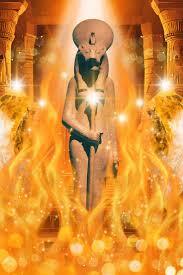 The burning lioness
The burning lionessWepset is also associated with the island of Biggeh, near Philae. Biggeh is a tomb of Osiris and Isis travels there every ten days to pour libations for Him. There, it is recorded at Philae, Wepset cooled Her rage. On Philae island itself, Wepset appears—in Her form of Hathor—in the mammisi, or birth house, where Isis bore Her son Horus.
The Gods are just as fluid as the Goddesses. At Philae, the Wandering Goddess/es are coaxed back to Egypt by Shu, Tefnut’s consort. Yet He also has a variety of names and forms, notably Onuris and Arsenouphis. Onuris, Anhur or Inhert in Egyptian, is a warrior and hunter. He is tied to the Wandering Goddess theme as the one Who brings back the wandering Lioness Goddess Mehyt. He also has sky associations and so is easily connected with Shu, Lord of the Air. Arsenourphis (Egyptian: Iry Hems-nefer, “the Good Companion”) is a Nubian God Who appears at Philae in a capacity similar to Onuris and Shu. Thoth, in several forms, serves as another of the amelioraters of the Goddess’ rage at Philae.
The book I’m reading about all this is by French Egyptologist Danielle Inconnu-Bocquillon. She says that there are no complete tellings of the Wandering Goddess myth at Philae, just references to key events in the myth. She notes that the parts of the myth we see at Philae are specific to Philae—as seems to be generally true in the temples. Each temple has their own specific version and details about their own Wandering Goddess in all Her many and varied forms.
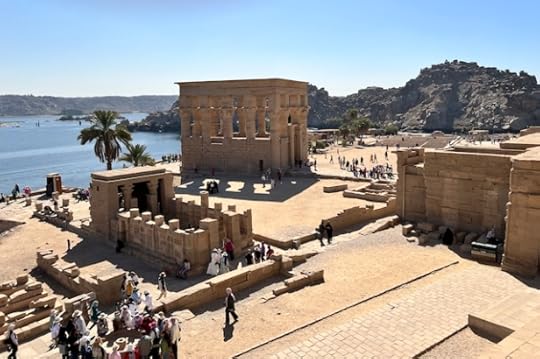 From the roof of Isis’ temple, the small Hathor temple is the structure to the left
From the roof of Isis’ temple, the small Hathor temple is the structure to the leftAt Isis’ temple of Philae, the angry Goddess is Tefnut-Wepset. The one Who brings Her back is Shu, in several of His forms, including as Thoth. The Returned Goddess is Hathor, which would explain the presence of a smaller Hathor temple on Philae. Apparently, there is, however, no specific reference to the myth in Hathor’s small temple. But the inscriptions and decorations of this temple were never finished. So I’m going to guess, there would have been such references.
Nevertheless, there are quite a lot of flame-y Goddesses at Philae. As Philae is the first temple the Wandering Goddess comes to as She returns from Nubia, that makes sense. Sakhmet is there as Mistress of Flame. Tefnut is Lady of the Flame in the House of Flame. The Goddess Satet, the Archer Goddess of the southern border, is also Mistress of Flame, as is Wepset. Mut appears as well as the Returning Goddess and thus She has a fiery form, too. Hathor is a Mistress of Flame and is shown as a dangerous Goddess at Philae. All the Goddesses are Eyes of Re and They are coming in HOT. They have not yet been made hotep, “satisfied” or “pacified.” As She/They arrive at Philae, Their anger is not yet cooled. Indeed, when the Goddess arrives at Philae, She is “surrounded by a large flame.”
 Art that reminds me of the Solar Eye Goddesses; by Alex Saveniji
Art that reminds me of the Solar Eye Goddesses; by Alex SavenijiWhat’s more, in the company of these Fiery Goddesses, Isis is Herself rather fierce. She is called Great of Magic Who Resides in Philae, Regent of Nubia, Great of Carnage in the Place of Execution, Mistress of Combat, Lioness, and Mistress of Slaughter. In fact, Isis and Tefnut share the very same furious epithets at Philae. And at least one inscription at the temple complex has Isis Herself arriving and “resting” at the Abaton (“untrodden” i.e. “pure” place)—something that the Returning Goddesses routinely do.
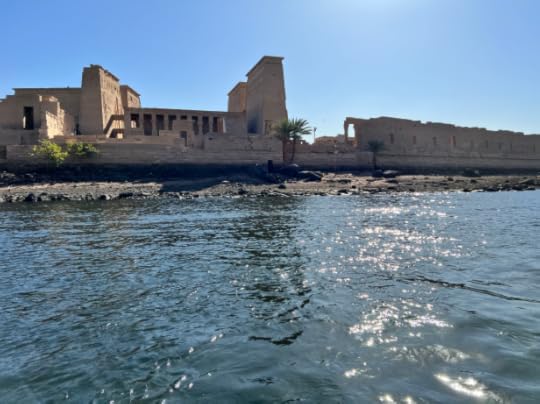 The holy island of Philae (Agilika) in the cool waters of the turquoise Nile
The holy island of Philae (Agilika) in the cool waters of the turquoise NileThe other thing that the Returning Goddesses do is to be purified and appeased so that Their angry, fiery Forms may be cooled—and the joyous festival of Their return celebrated. At the Abaton, we find Nephthys, Isis, Wepset, and Hathor all being appeased.
In the Philae area, the Abaton is the island of Biggeh, which has a tomb of Osiris. Isis visits there every 10 days to pour libations for Him.
So here’s how that goes: the inscription says that Isis, as Wepset (the angry Goddess), returns from Nubia and stands upon the High Hill (that is, the tomb of Osiris). There She is appeased, then settles in Philae “in Her name of Hathor.”
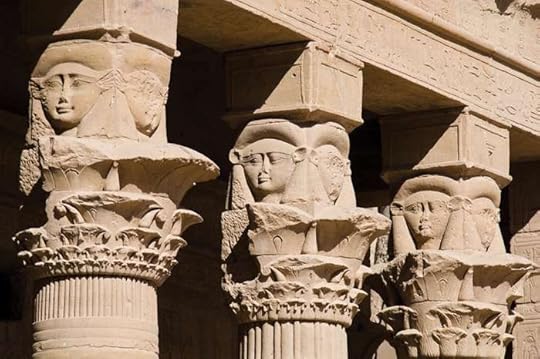 Hathor on the mammisi on Philae
Hathor on the mammisi on PhilaeSettled at Philae, wensheb—a type of waterclock associated with Thoth and offered to Wandering Goddesses as a symbol of return to Right Order—is offered to Isis, Who is accompanied by Tefnut, and to Isis, Who is accompanied by Hathor—as well as the other Fiery Eye Goddesses.
It seems that, as the Lady of Philae, Isis is all these Goddesses; and that They are all Her. The more I get to read the actual temple inscriptions from the actual temples, the more it becomes clear not that “All the Goddesses are One Goddess” as Dion Fortune’s famous aphorism says. But instead, when it comes to Egypt, “All the Goddesses are All the Goddesses.”
Oh yes, there’s much more to delve into here.
But for now, I am going to leave you with a hymn to Hathor Who Is Isis and Isis Who is Hathor, from Hathor’s small temple at Philae. Perhaps you will find it useful in your own invocations of Our Lady.
“How beautiful is Your face when You appear in glory and joy, Great Hathor, Lady of Senmut, Venerable Hathor, Lady of the Enclosure of the Calling. Your father Re exults when You arise, Your brother Shu pays homage to Your face. Thoth, powerful in intoxicating drink, He calls, O Powerful One. The Great Ennead is in pleasure and joy, the baboons are before Your face and dance for Your Majesty, the Hity beat the tambourines for Your ka, the Beings sing hymns for You and worship You. The Henemenet bow before Your power, men and women pray to you to give them love. For You the virgins open the festivities and give You their protective spirit. You are the Mistress of Praise, the Mistress of Dance, Great in Love, Mistress of Women and the Beautiful. You are the Mistress of Drunkenness, of Many Feasts, the Mistress of Frankincense, the Mistress of Braiding the Crown, the Mistress of Gaiety, the Mistress of Exultation to Whose Majesty Music is Made; Venerable Female Pillar, Female Ba in Bougem; You are the Mistress of the Sakhem Sistrum [the loop sistrum], the Mistress of the Menat and the Seshesh Sistrum [the naos sistrum] to Whose ka the wensheb [a type of waterclock associated with Thoth and offered to Wandering Goddesses as a symbol of return to Right Order] is raised. You are the Mistress of Dance, the Mistress of Song and Dance to the Lute, Whose Face Shines Every Day, She Who is Ignorant of Sorrow. May You be present in Your Beautiful Face.”
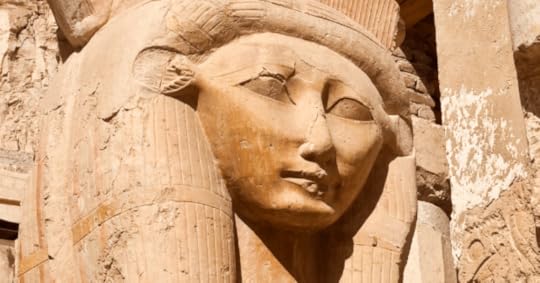 Hathor, in Her Beautiful Face
Hathor, in Her Beautiful Face



